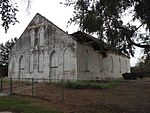Mansfield (Petersburg, Virginia)
Central Virginia Registered Historic Place stubsHouses completed in 1750Houses in Dinwiddie County, VirginiaHouses on the National Register of Historic Places in VirginiaNational Register of Historic Places in Dinwiddie County, Virginia ... and 1 more
Plantation houses in Virginia

Mansfield is a historic plantation house located near Petersburg, Dinwiddie County, Virginia. It was built in stages starting about 1750, and is a 1+1⁄2-story long and narrow frame dwelling with a hipped roof. It has a hipped roof rear ell connected to the main house by a hyphen. It features an octastyle Colonial Revival porch stretching the full length of the front facade.It was listed on the National Register of Historic Places in 1976.
Excerpt from the Wikipedia article Mansfield (Petersburg, Virginia) (License: CC BY-SA 3.0, Authors, Images).Mansfield (Petersburg, Virginia)
Ferndale Road,
Geographical coordinates (GPS) Address Nearby Places Show on map
Geographical coordinates (GPS)
| Latitude | Longitude |
|---|---|
| N 37.220277777778 ° | E -77.470555555556 ° |
Address
Ferndale Road 25026
23803
Virginia, United States
Open on Google Maps










